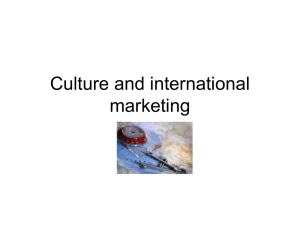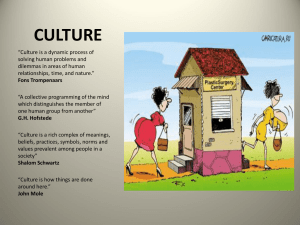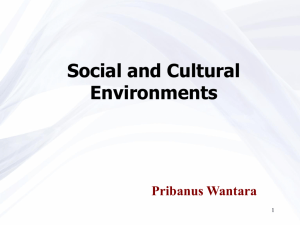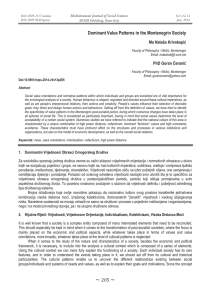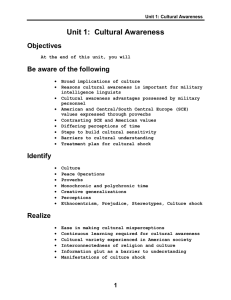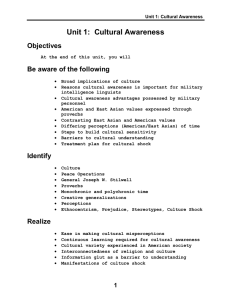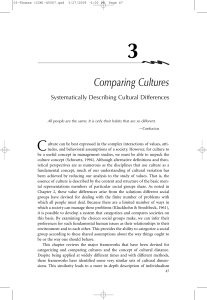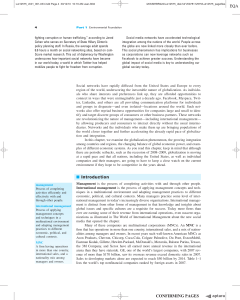Culture_and_international_marketing
advertisement
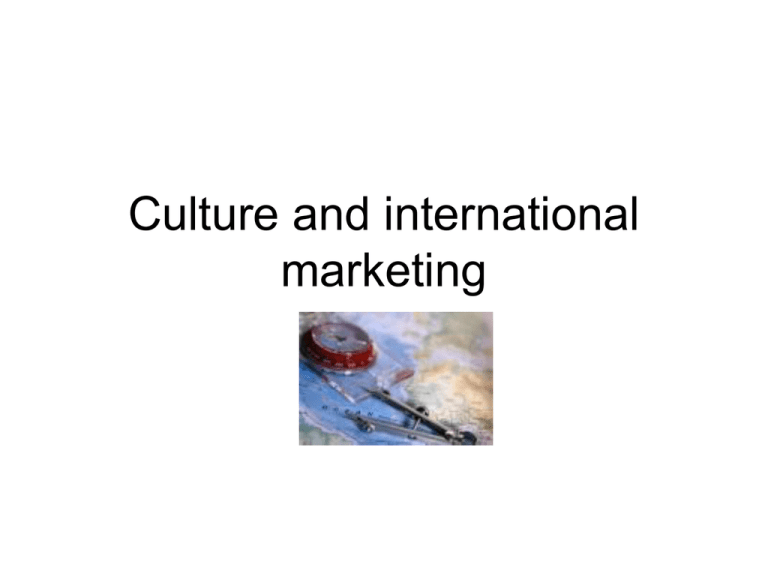
Culture and international marketing Culture Defined • A continuously changing totality of learned and shared meanings, rituals, norms, and traditions among the members of an organization or society. – Ecology – Social Structure – Ideology Culture and??? • Heaven is where the cooks are French, the mechanics are German, the policemen are English, the lovers are Italian, and it is all organized by the Swiss. Hell is where the policemen are German, the mechanics are French, the cooks are British, the lovers are Swiss, and its is all organized by the Italians Elements of Culture • Spoken/Written Language – Differences in meaning in different countries which share the same language – Dealing with multiple dialects – High costs of translation – High costs of translation blunders • Nonverbal communication – – – – – – – – Proxemics Postures Orientations Chronemics Haptics Kinesics Paralinguistics Appearances – + ART (dance, music, pictures, statues…) Comparisons & Contrasts Japan North America Myth / Hero Emphasis Group Individual Self-Denial Dependence Self-Expression Independence Emphasis Obligations Rights Style Cooperation Competition Assumptions Interdependence Independence View of Self Organization Man Individual With a Skill Attitude Culture and Decision-making Consumer decisions are Language and religion affects how markets culturally influenced - husband and wife equal roles? - what influence from children? - does one family member dominate in choice? communicate - grouping countries by language or religion? - grouping markets within a core language? - is religion a useful criterion for grouping? High vs. Low Context Cultures Edward Hall http://edwardthall.com/ • Low-Context cultures: – – – • What is said is precisely what is meant Messages are explicit Words carry most of the information in communication Switzerland, Germany, Scandinavia, United States High-Context cultures: The context of the message— the message source, his or her standing in society or in the negotiating group, level of expertise, tone of voice, and body language—are all meaningful – – – Less information is contained in the verbal part of the message More information resides in the context of communication (background, associations, basic values of communicators) Japan, Saudi Arabia, Latin America, Italy and Spain MONOCHRONIC VS POLYCHRONIC CULTURES: Time is money“ USA, „Those who rush arrive first at the grave (Spain), „Before the time, it is not the time; after the time, it´s too late“ (France) PROXEMIC – DISTANCE, SPACE (in-group, outgroup, physical space…), e.g. frinedship patterns, „size“ of family, guanxi „touch“ coulture – to show intimity in ads Advertising: Europe vs Saudi Arabia „touch culture“ Monochronic/Polychronic Cultures Monochronic People • do one thing at a time • concentrate on the job • take time commitments seriously • are committed to the job • show respect for private property; rarely borrow or lend • are accustomed to short-term relationships • • • • • • Polychronic People do many things at once are highly distractible consider time commitments casually are committed to people borrow and lend things often tend to build lifetime relationships Religion • Protestant Religion – stresses hard work and frugality • Judaism – stresses education and development • Islam – focus on rules for social interaction • Hinduism – encourages family orientation and dictates strict dietary constraints • Buddhism – stresses sufferance and avoidance of worldly desires • Business days • Holidays • Consumption patterns – alcohol, meat… • Gender roles • Gift giving • Marketing practices • Time Orientation • Status Concern and Materialism • Other – Marketing mix Cultural Variability – cult. dimensions (Geert Hofstede) • Power Distance • Uncertainty Avoidance • Masculinity Versus Femininity • Individualism Versus Collectivism • Long-terms versus short term orientation http://www.geert-hofstede.com/ Power-distance. differences in people accept or expect access to power. A a high power-distance country, like Malaysia, displays customers and average citizens less prominently. Authority roles are enforced by such images as official certification logos. A low power-distance country would emphasize equality among social and age groupings. Uncertainty avoidance. Tolerance for ambiguity. High uncertainty-avoidance countries would respond better to a simple manner of navigation. A low uncertainty-avoidance country would prefere a site with complex navigation with a multitude of link choices. An example of a high uncertainty-avoidance country would be Belgium; a low uncertainty-avoidance country would be Singapore Femininity vs. masculinity. gender roles, not physical characteristics. High-femininity countries blur the lines between gender roles, while high-masculinity countries display traditional role expectations. High-masculinity countries respond to Web sites that speak directly to traditional gender roles. High-masculinity: Japan, Low-masculinity: Sweden. Collectivism vs. individualism. – Collectivism: people integrated into strong groups that protect them in exchange for unbridled loyalty. – Individualism: a person’s strong sense of self and that of his or her immediate blood relations. – A collectivist country would show groups of people in images, – Individualistic countries would most likely find site content and images with a single person accomplishing a challenge more appealing. The United States is an example of an individualistic country. Long-term vs. short-term orientation. Long-term emphasizes practice and practical value. Short-term focus their content on truth and the certainty of beliefs. Hofstede’s cultural dimensions – scores by countries Arab World Austria Denmark Finland France Germany Hong Kong India Italy Japan Mexico Netherlands Peru Portugal Sweden PDI 80 11 18 33 68 35 68 77 50 54 81 38 64 63 31 IDV 38 55 74 63 71 67 25 48 76 46 30 80 16 27 71 MAS 52 79 16 26 43 66 57 56 70 95 69 14 42 31 5 UAI 68 70 23 59 86 65 29 40 75 92 82 53 87 104 29 LTO 31 96 61 80 44 33 http://www.geert-hofstede.com/marketing.shtml Advertising styles De Mooij, 2004 Cultural values • • • • • • Enduring beliefs about a specific mode of conduct or desirable end-state Guide the selection or evaluation of behavior Are ordered by importance in relation to one another to form a system of value priorities Enculturation Process by which individuals learn the beliefs and behaviors endorsed by one’s own culture Acculturation Learning a new culture Assimilation Maintenance of the new culture, and resistance to new cultures and to one’s old culture http://www.youtube.com/watch?v=7XHioryoMes&feature=r elated Doing business in China Cultural norms • Norms are derived from values and defined as rules that dictate what is right or wrong, acceptable or unacceptable – Imperative • What an outsider must or must not do – Exclusive • What locals may do but an outsider cannot – Adiaphora • What an outsider may or may not do http://www.funenclave.com/fun-stuff/german-culture-versus-chinese-culture-13076.html http://stephan.dahl.at/research/online-publications/intercultural-research http://www.slideshare.net/ibahrine/ibahrine-chapter-3-value-culture • http://wps.pearsoned.co.uk/ema_uk_he_h ollensen_globalmark_4/64/16424/4204693 .cw/index.html
